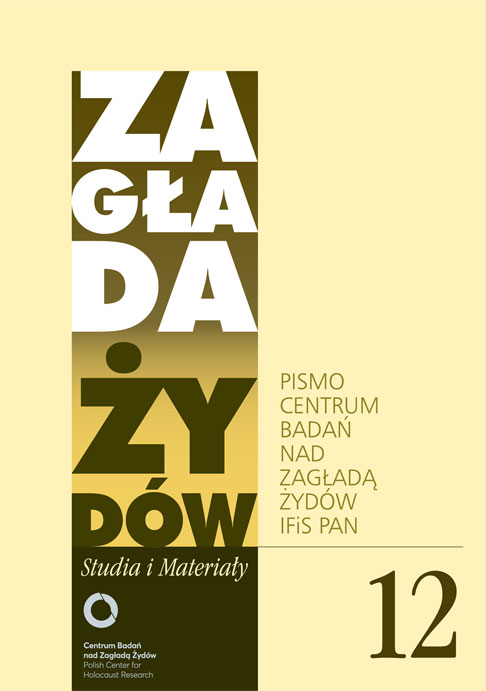Niemieccy okupanci w Warszawie a jawność Holokaustu
Zagłada Żydów. Studia i Materiały, Nr 12 (2016), Strony: 70-90
Data zgłoszenia: 2020-10-19Data publikacji: 2016-11-30
 https://doi.org/10.32927/ZZSiM.408
https://doi.org/10.32927/ZZSiM.408
Abstrakt
In several last years there have been many publications concerning the knowledge and attitudes of Germans in relation to the Holocaust. The author deals with the issue what the civilian population and the military troops stationed at that time in Warsaw knew about the Holocaust. The occupants quickly learned about the massacres of Jews. Precise information spread at a rapid pace, and consequently each of the occupants was well informed of the Holocaust. Very few Germans stationing in Warsaw condemned crimes committed against the Jews. There was consensus on the need of extermination of Jews, some reservations aroused only form in which the genocide was carrying on. Open violence intertwined with its general acceptance, which led to a progressive callousness.
Słowa kluczowe
wiedza o Zagładzie , Warszawa, , okupanci , jawność
Licencja
Prawa autorskie (c) 2016 Autor&"Zagłada Żydów. Studia i Materiały"

Utwór dostępny jest na licencji Creative Commons Uznanie autorstwa 4.0 Międzynarodowe.
https://creativecommons.org/licenses/by/4.0
Czasopismo publikowane jest w standardzie Diamond Open Access na licencji CC-BY-4.0 Deed - Uznanie autorstwa 4.0 Międzynarodowa - Creative Commons
Inne teksty tego samego autora
- Stephan Lehnstaedt, Holokaust w niemieckiej literaturze naukowej ostatnich pięciu lat , Zagłada Żydów. Studia i Materiały: Nr 7 (2011)
Podobne artykuły
- Marta Tomczok, Literatura polska wobec Zagłady 2000 – 2024. Bilans subiektywny , Zagłada Żydów. Studia i Materiały: Nr 20 (2024)
- Tomasz Łysak, Yolocaust: kapitalizm platform a cyfrowe praktyki upamiętniania Zagłady , Zagłada Żydów. Studia i Materiały: Nr 17 (2021)
- Joanna Tokarska-Bakir, Bełk i inne miejsca. Opowieść o dziesiętnikach-zastawnikach , Zagłada Żydów. Studia i Materiały: Nr 15 (2019)
- Maria Sławek, Muzyka jako forma upamiętnienia powstania w getcie warszawskim , Zagłada Żydów. Studia i Materiały: Nr 19 (2023)
- Maria Ferenc-Piotrowska, „Czarna, ogromna chmura wisi nad nami i na pewno spadnie…” Żydzi w miastach i miasteczkach Generalnego Gubernatorstwa wobec wiadomości o akcji „Reinhardt” , Zagłada Żydów. Studia i Materiały: Nr 13 (2017)
- Marta Duch-Dyngosz, Magdalena Waligórska, Wąskie widzenie winy: Granice kolaboracji w świadomości świadków w procesach sierpniowych , Zagłada Żydów. Studia i Materiały: Nr 19 (2023)
- Anka Grupińska, Dariusz Libionka, Rozmowa z Józefem Grynblattem, członkiem Betaru i Żydowskiego Związku Wojskowego w czasie powstania w getcie warszawskim , Zagłada Żydów. Studia i Materiały: Nr 3 (2007)
- Johannes Breit, Lukas Meissel, Igraszki z symboliką Zagłady. Seria gier komputerowych „Wolfenstein” jako studium przypadku cyfrowych reprezentacji Zagłady , Zagłada Żydów. Studia i Materiały: Nr 17 (2021)
- Andrzej Żbikowski, Joanna Beata Michlic, Poland’s threatening other. The image of the Jew from 1880 to the present , Zagłada Żydów. Studia i Materiały: Nr 4 (2008)
- Andrzej Żbikowski, Texts Buried in Oblivion. Testimonies of Two Refugees from the Mass Grave at Poniatowa , Zagłada Żydów. Studia i Materiały: 2008: Holocaust Studies and Materials
<< < 1 2 3 4 5 6 7 8 9 10 11 12 13 14 15 16 17 18 19 20 21 22 23 24 > >>
Możesz również Rozpocznij zaawansowane wyszukiwanie podobieństw dla tego artykułu.
 English
English
 Język Polski
Język Polski



 https://orcid.org/0000-0001-6894-9587
https://orcid.org/0000-0001-6894-9587

